Walton Goggins To Star Alongside Mel Gibson In ‘Fatman’
EXCLUSIVE: Walton Goggins has been cast as a lead in Fatman, the dark action comedy that stars Mel Gibson, who is playing Santa Claus. The casting reunites Goggins again with Rough House Pictures, which produced HBO’s Vice Principals, produces the current The Righteous Gemstones, and which is producing Fatman.
The film, originally launched at the Cannes market last spring, has also added Todd Courtney of Mammoth Entertainment to the producing team, with Mammoth now set to finance alongside Ingenious Media. The Nelm Brothers (Small Town Crime) are directing based on their original screenplay. Production is underway in Canada.
Fatman centers on a neglected and precocious 12-year-old who hires an unorthodox hitman to kill Santa Claus after receiving a lump of coal in his stocking. Goggins will star as Skinnyman, the eccentric, sharp-shooting hitman who works at a toy store.
Related Story Mel Gibson Suits Up To Play Santa Claus In Action Comedy 'Fatman' - Cannes
Brandon James of Rough House, Fortitude’s Nadine de Barros, Michelle Lang and Skywolf’s Lisa Wolofsky are also producing along with Robert Menzies. Fortitude will continue to sell the project to buyers internationally next month at the European Film Market in Berlin. CAA is repping domestic rights.
Rough House partners Danny McBride, David Gordon Green and Jody Hill are executive producers with Ingenious’ Peter Touche and Sam Allwinton.
Goggins, who won a Critics’ Choice Award in 2018 for his role on Vice Principals, also is in the cast of Gemstones, which has been renewed for a second season. He currently produces and stars on CBS’ freshman comedy The Unicorn, which has received a full-season pickup. His recent film credits include Three Christs, which bowed earlier this month via IFC Films, along with Them That Follow, Tomb Raider, The Hateful Eight and Ant-Man and the Wasp.
He’s repped by ICM Partners and Darris Hatch Management and Production.
Joint Projects Between Sudan and Chad on Precious Stones Extraction
Khartoum, Jan.28 (SUNA)- The Public Authority for Geological Research affirmed that there are several joint projects on mining field could be implemented between Sudan and Chad.
Director-General of the Public Authority for Geological Research Engineer Suleiman Abdul-Rahman unveiled that projects could be implemented for utilizing minerals of graphite and iron which are extended in the Sudanese and Chadian lands in addition to extracting precious and semi- precious stones existent in the two countries .
Making remark at conclusion of visit of delegation Chadian Authority for Gold and Precious Metals Engineer Suleiman said such projects could enhance relations between the two countries .
He said that Sudan is working to make use of wide experiences of Chad in area of diamond mining.
The Director-General of Chadian Authority for Gold Mohamed Adam Beshr, for his part, said that they came to Sudan to get acquainted with its wide experiences in mining, laws, regulations and plans drawn up by Sudan to utilize these resources .
AB
The Fullest List Of Organic Gemstones
We all know that gemstones are minerals and rocks, right? Wrong! As it often happens, some gemstones, despite their name, are not stones. Instead, these are the materials of biological origin that come from animals or plants and values for their rarity and appearance to the same extent as we value crystals.
Organic gemstones also include a group of valuable materials that are biological in origin but have been mineralized: biological materials have been replaced by opal, calcite, pyrite, or other mineral materials. Formally, it is no longer organic, but it is still unique as the organic structures, and internal shapes have been preserved. Leading examples are fossils of wood, coral, sea organisms, and bones.
Here we attempted to compile a full list of gemstones of organic origin. Most commonly known and widely used in jewelry and arts are pearl, mother of pearl, coral, amber, bone, and ivory. The extended list includes ammolite, ammonites, crinoids, dinosaur bone, fossilized coral and bryozoans, jet, mary ellen jasper, opalized wood, peanut wood, petrified wood, petrified palm, sand dollars, and turritella agates.
Amber 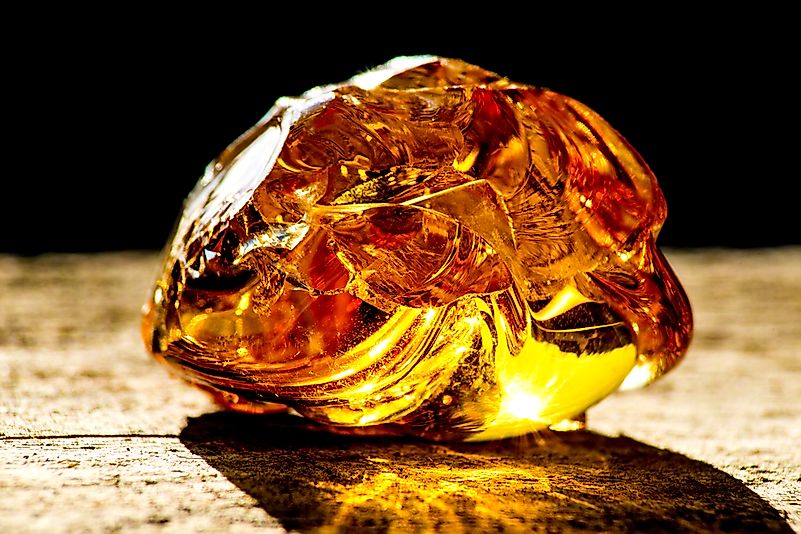 Amber in the sun.
Amber in the sun.
Amber is a variety of valuable fossilized resins of ancient coniferous plants. Its transparency and color vary, with most valuable varieties being highly transparent bright yellow, gold, or orange. Some Ambers also come in blue or black; the "youngest" ambers (a couple of million years) sometimes appearing green. It is remarkably light, can be burnt as an incense, and produces static electricity if rubbed against wool. Many ambers contain elements of prehistoric plants or insects.
Ammonite And Ammolite 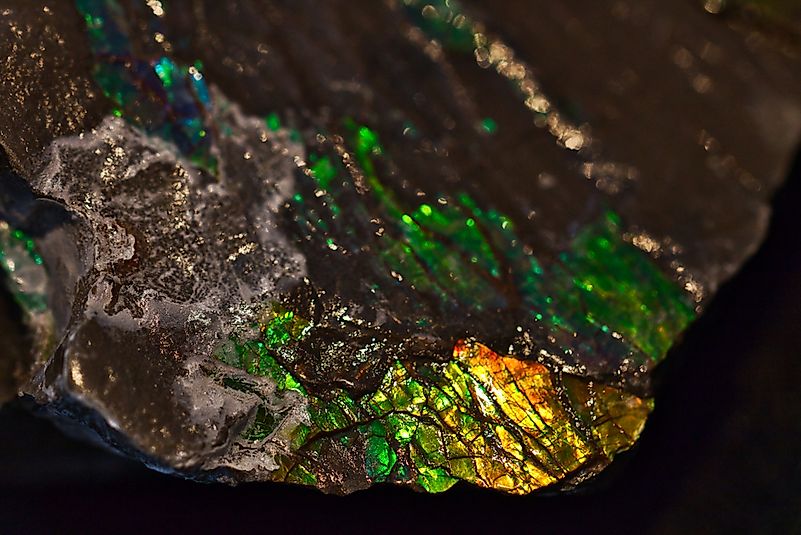 Colourful Ammolite crystal.
Colourful Ammolite crystal.
Ammonites are fossilized chambered shells of extinct marine invertebrate, distant relatives of octopuses, and cuttlefish. Their shells can be used in decoration or elements of jewelry. Ammolite is a trading name used for the most valuable part of the shell: a fragile iridescent layer producing a spectacular play of intensely bright colors. The entire supply of ammolite comes from a single location in Canada.
Crinoidal Limestone 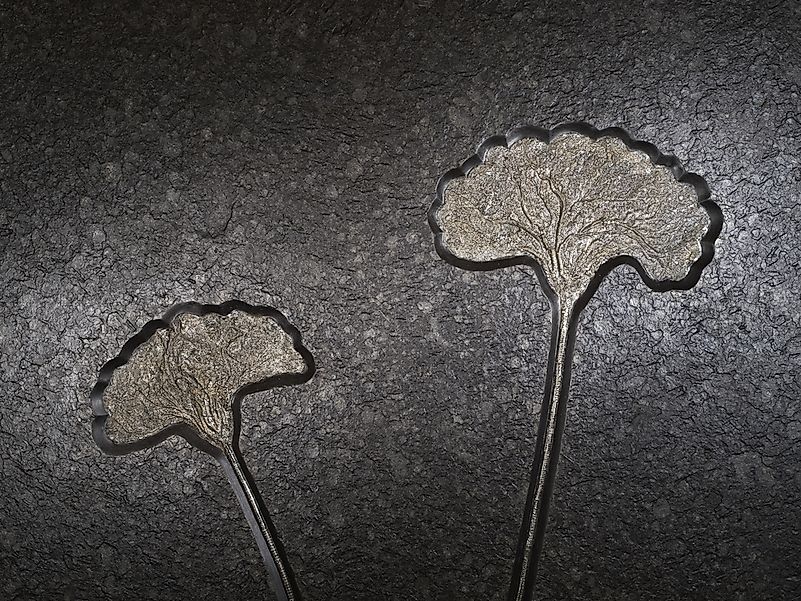 Crinoid sea lily fossil feature on bedrock.
Crinoid sea lily fossil feature on bedrock.
Crinoids used to live at the bottom of the ocean. Even though they resembled stemmed plants, they were in fact invertebrates. Limestone and dolomite are where their fossils are typically found. The fossils can transform into some interesting gems once they are cut and polished.
Coral And Fossil Coral 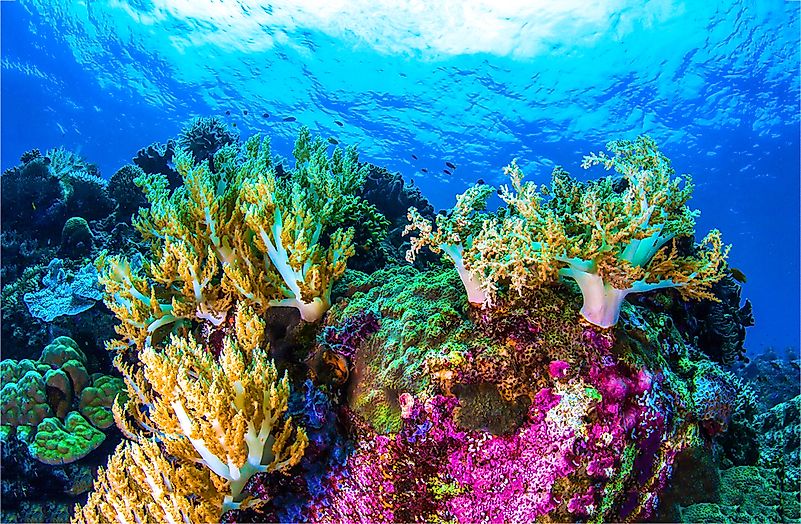 Underwater coral reef.
Underwater coral reef.
Coral is an external skeletal shell structure built by colonial polyps similar to those living in warm, shallow marine waters and creating the reefs. The precious coral, however, comes mainly from several dark-loving species occupying deeper rocky plates and crevices. Valuable colors of the coral can be dark-red, orange-red, orange-pink, pink, white, blue, or black. Corals can be carved or even polished as used in their natural branch form.
Fossilized corals are corals of the ancient seas. They have been fossilized by changing the native calcium carbonate with calcite or quartz.
Dinosaur Bone 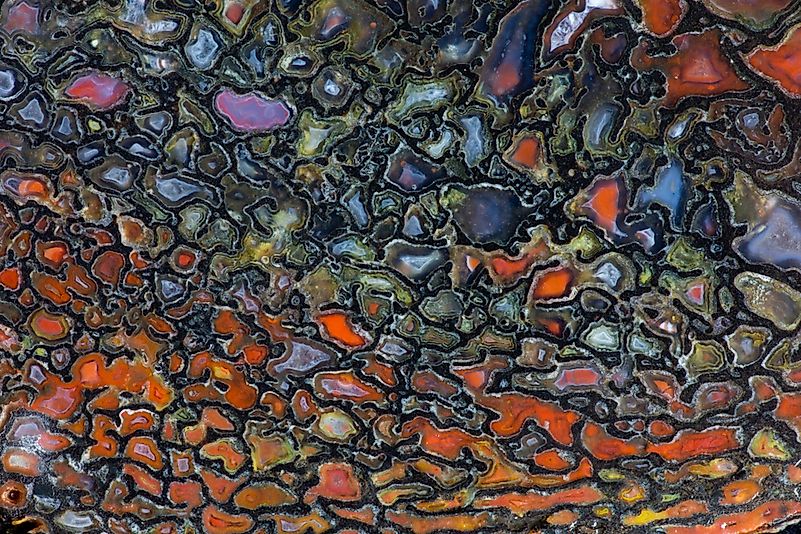 Petrified dinosaur bone.
Petrified dinosaur bone.
Although all dinosaur bones can be objects of curiosity and have a scientific value, not every dinosaur bone makes a gem. Dinosaur bone becomes a gem when the conditions allow for petrification, that is when organic materials undergo mineral replacement with chalcedony, pyrite, or quartz. The replacing minerals can sometimes be quite colorful, and the result of the petrification carries both the pattern of the structures of the initial organism and the qualities of the new mineral.
Mary Ellen Jasper 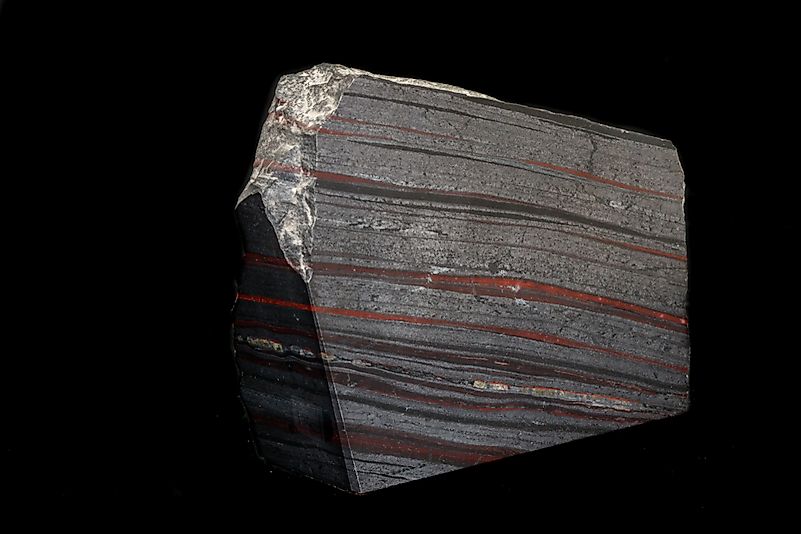 Mary Ellen Jasper stone.
Mary Ellen Jasper stone.
Mary Ellen Jasper is a mix of red jasper and silver hematite found in Mary Ellen Mine in Minnesota (hence the name). This gem is a fossil stromatolite, a layered structure created by ancient sediment-trapping microbial mats. Not only is this gem quite beautiful thanks to its dominant bright red color, but it is also incredibly ancient. The algae that created stromatolites in Mary Ellen dates two billion years back: long before any other plant or creature that we find in fossils inhabited Earth.
Petrified Wood 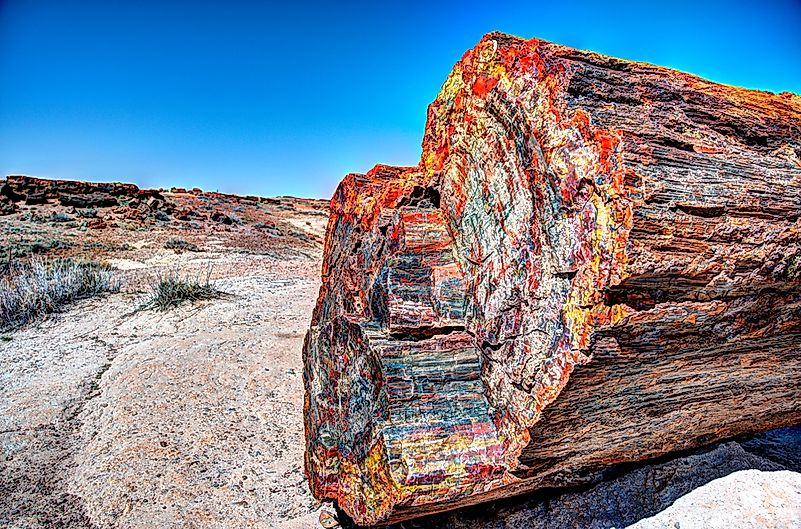 Petrified multicolored wood.
Petrified multicolored wood.
This fossil forms when wood material is buried for over a million years. Over time the substances dissolved in the groundwater slowly precipitates and infills the wood structures with silica, calcite, chalcedony, or other mineral material. Not all petrified wood is of gem quality, but many pieces are suitable for decorative purposes.
Petrified Palm 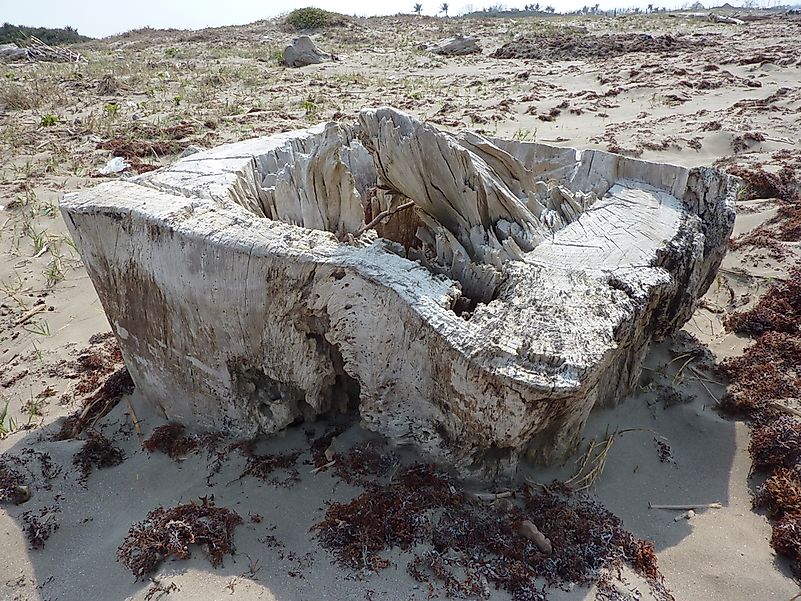 Chopped base of a petrified palm tree found at the beach in Veracruz, Mexico.
Chopped base of a petrified palm tree found at the beach in Veracruz, Mexico.
Petrified Palm is a state fossil of Lousiana. This fossilized material is commonly found in Oligocene-age sediments (between 20 - 40 million years ago). It differs from the petrified wood by the nature of the palm trees: it is fossilized parenchyma, fibrous material of which palm trees are made. It is not particularly expensive but can be polished into attractive lightweight brown "stones" with easily identifiable patterns. Fossilized palm roots can be particularly interesting because of their contrasting patterns.
Peanut wood 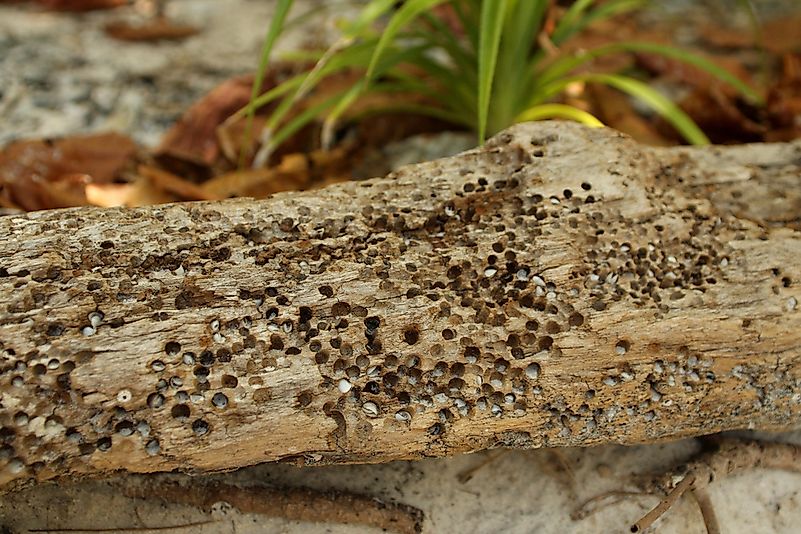 Driftwood with holes made by shipworms (Teredo Navalis).
Driftwood with holes made by shipworms (Teredo Navalis).
"Peanut wood" is not really from peanuts: it is a variety of dark brown and black petrified wood with contrasting white patterns from which it got its name. Peanut wood is a fossil of driftwood that had been intensively drilled by a marine wood-boring clam called Teredo, and then sank to the bottom of the sea and had the resulting channels infilled with white radiolarian sediments. The typical age is around 120 million years old; Australia is known for some of the most exceptional finds.
Opalized Wood 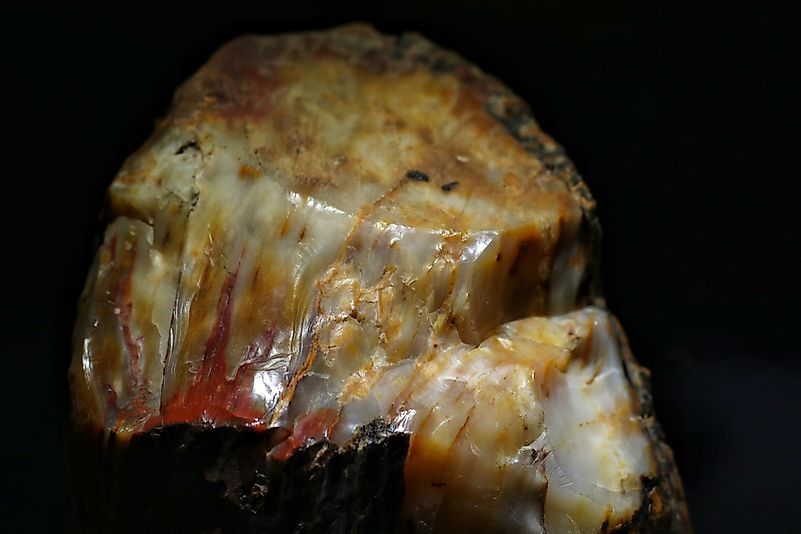 Opal from petrified wood.
Opal from petrified wood.
Opalized wood is the rarest of all petrified woods and can be truly stunning. Some of the most famous examples of the opalized wood come from the species of Herringbone Sequoia. This wood underwent fossilization with the common opal lending it the attractive flash of colors intermixed with the dark "woody" elements.
Pearls 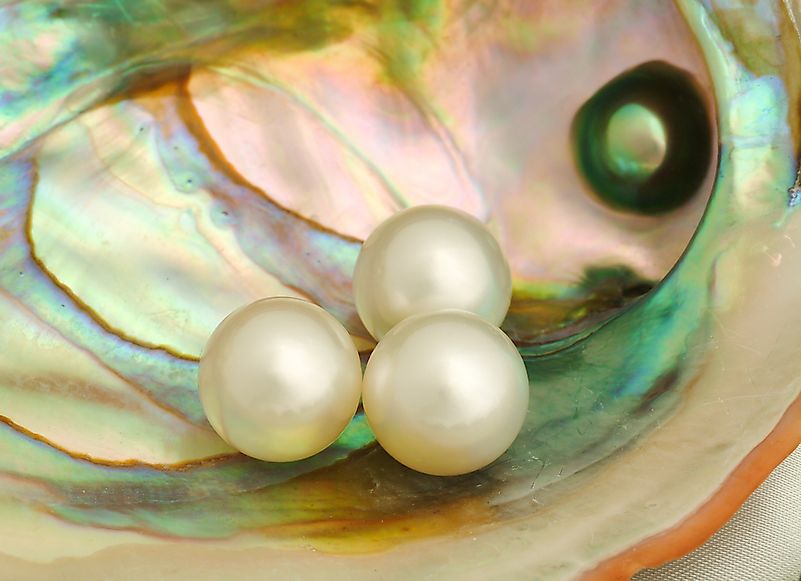 Natural south seas pearls.
Natural south seas pearls.
The queen of gemstones is a softly glowing or iridescent organic gem produced by mollusks and several other groups of shellfish. Pearls are undoubtedly the most important of all organic gems. Pearls have been appreciated for over 6,000 years. Fragile and sensitive gemstone does not require any processing, and, unlike all other gemstones, can be cultivated.
Mother of Pearl 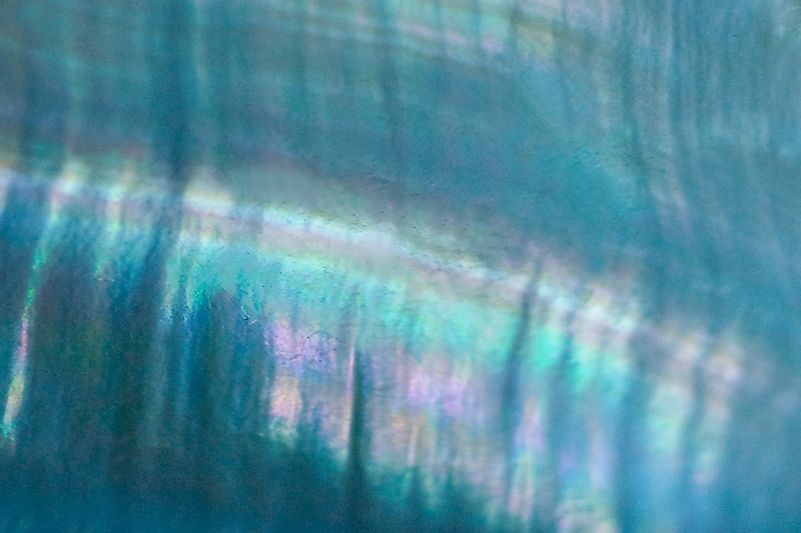 Mother of pearl.
Mother of pearl.
Often marketed as "MOP," is the thin iridescent and rainbow-colored nacreous layer of a mollusk shell. Some types of Mother of Pearl are more striking and more valuable than others, notably the abalone shells. Tridachna Gigas shell deserves a special mention, although it cannot be classified as a MOP: Chinese jewelers call it "the whitest of all gemstones." It produces enormous "pearls" that look nothing like other pearls we know because they do not have luster, but the sheer size of it makes it valued by collectors.
Ivory 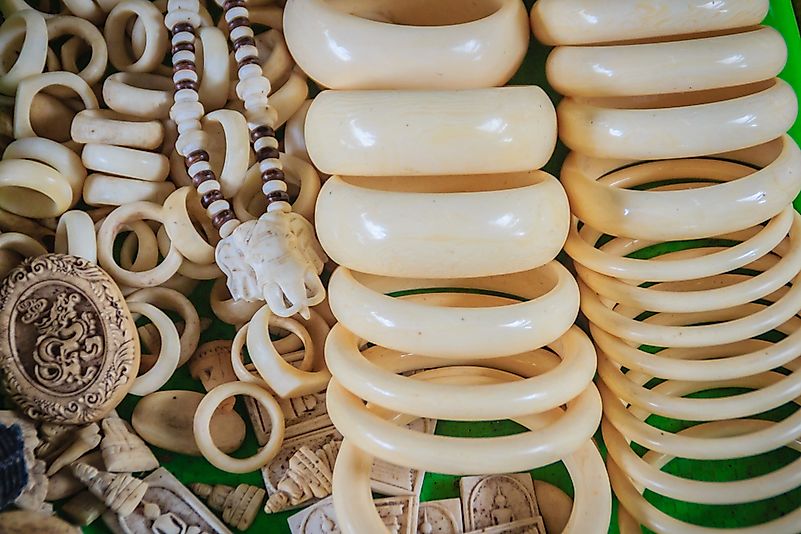 Souvenirs and amulets carved from Ivory for sale at Thai-Cambodia border market.
Souvenirs and amulets carved from Ivory for sale at Thai-Cambodia border market.
Ivory is convincingly the most controversial of all the gems on our list. It is made from the elephant tusks but also from the teeth of other large mammals such as walrus, hippopotamus, and even wild boar. Most countries in the world now either heavily restrict or completely ban the import and sale of ivory. The reason behind this is that hunting elephants for their tusks almost drove these animals to extinction not so long ago.
Turritella Agate 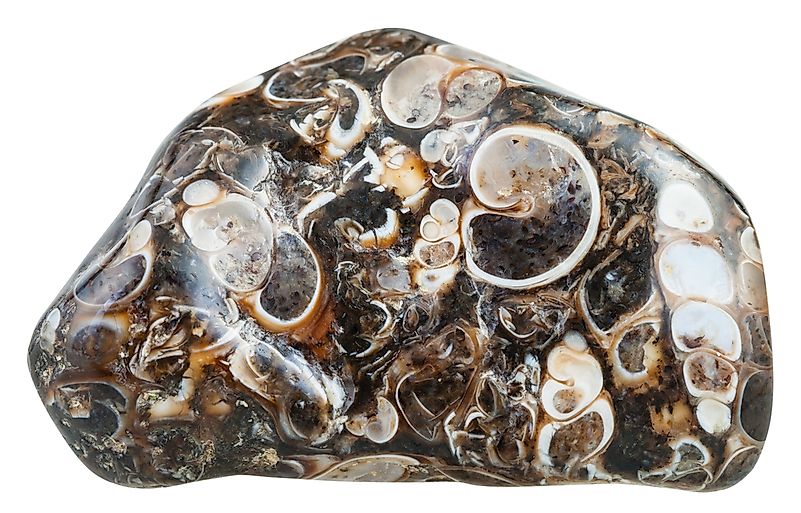 Tumbled turritella agate (jasper) from Madagascar gemstone.
Tumbled turritella agate (jasper) from Madagascar gemstone.
This rolling name was given to this agatized fossil by mistake. What was known as "Turritella" for several decades is a dark brown or greyish gem material containing obviously visible spiral fossil snail shells inside a semi-transparent agate body. Those shells were thought to belong to a genus of fossil snails Turritella. Still, later it was discovered that the correct snail species was "Elimia tenera," a member of the Pleuroceridae family. While the Turritella name remains, for now, the scientifically accurate one would be "Elimia Agate."
Jet 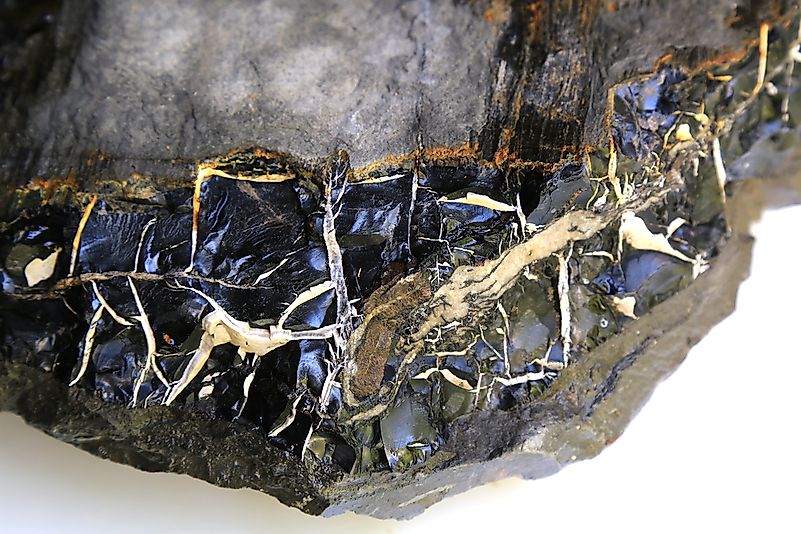 Jet from Holzmaden, Baden-Wuerttemberg, Germany.
Jet from Holzmaden, Baden-Wuerttemberg, Germany.
Jet is the gemstone that lent deep, impenetrable darkness its name: "jet-black."
Jet is a coalified wood, which forms differently from the normal coal. Most coal seams form when a buried ancient swamp with woody material undergoes degradation, heating, and pressure. Jet does not form in a seam. Jet can be created when an individual piece of wood from a half a dozen of species with suitable characteristics sinks to the bottom of the body of water and gets covered by organic-rich sediment. Compacted and heated in isolation inside an oils-rich shale, it absorbs the oil into its structures and transforms into a rock that is quite different from typical coal.
Is ivory legal to sell or buy?
Most countries in the world now either heavily restrict or completely ban the sale and import of elephant ivory because hunting elephants for their tusks nearly drove these animals to extinction.
No comments:
Post a Comment